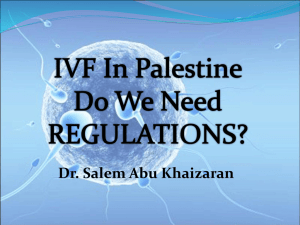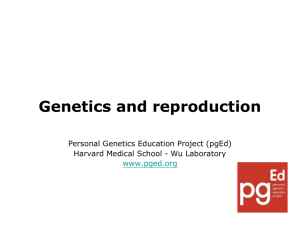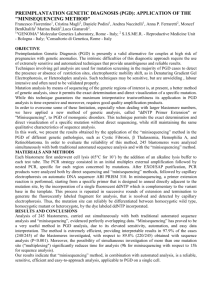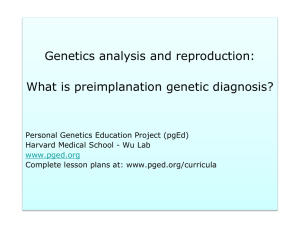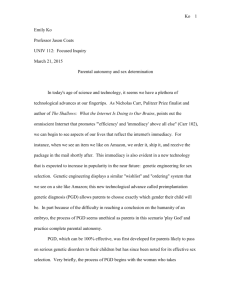Embryonic Stem Cell Research Debate Indirectly Focuses Spotlight on Safety... Preimplantation Genetic Diagnosis
advertisement
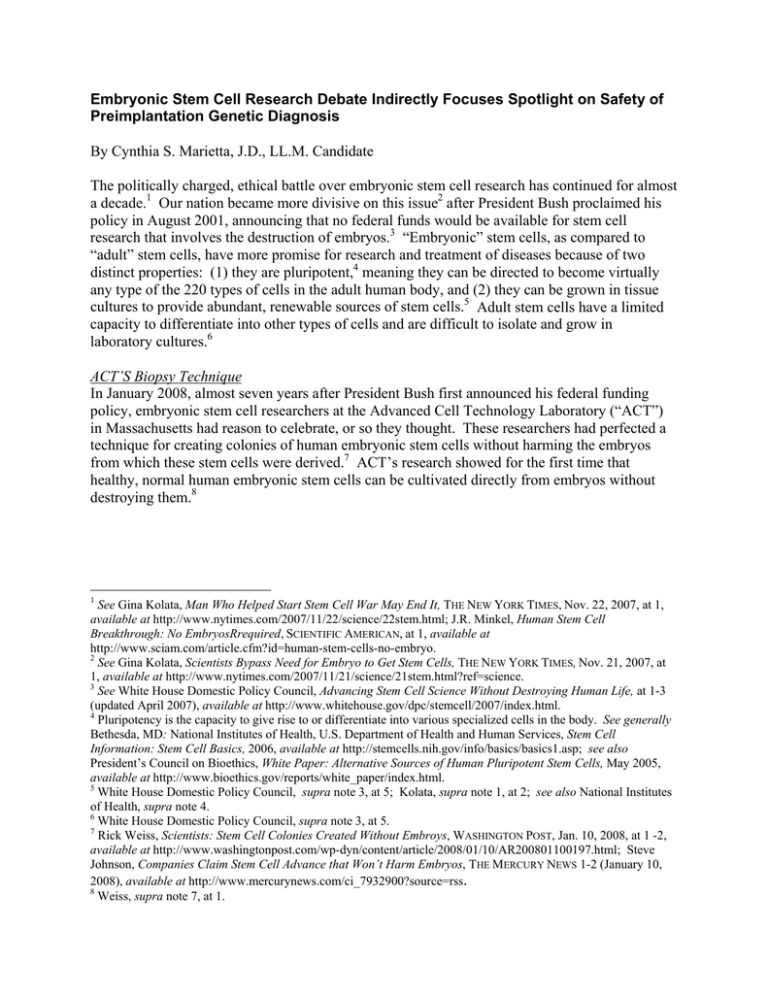
Embryonic Stem Cell Research Debate Indirectly Focuses Spotlight on Safety of Preimplantation Genetic Diagnosis By Cynthia S. Marietta, J.D., LL.M. Candidate The politically charged, ethical battle over embryonic stem cell research has continued for almost a decade.1 Our nation became more divisive on this issue2 after President Bush proclaimed his policy in August 2001, announcing that no federal funds would be available for stem cell research that involves the destruction of embryos.3 “Embryonic” stem cells, as compared to “adult” stem cells, have more promise for research and treatment of diseases because of two distinct properties: (1) they are pluripotent,4 meaning they can be directed to become virtually any type of the 220 types of cells in the adult human body, and (2) they can be grown in tissue cultures to provide abundant, renewable sources of stem cells.5 Adult stem cells have a limited capacity to differentiate into other types of cells and are difficult to isolate and grow in laboratory cultures.6 ACT’S Biopsy Technique In January 2008, almost seven years after President Bush first announced his federal funding policy, embryonic stem cell researchers at the Advanced Cell Technology Laboratory (“ACT”) in Massachusetts had reason to celebrate, or so they thought. These researchers had perfected a technique for creating colonies of human embryonic stem cells without harming the embryos from which these stem cells were derived.7 ACT’s research showed for the first time that healthy, normal human embryonic stem cells can be cultivated directly from embryos without destroying them.8 1 See Gina Kolata, Man Who Helped Start Stem Cell War May End It, THE NEW YORK TIMES, Nov. 22, 2007, at 1, available at http://www.nytimes.com/2007/11/22/science/22stem.html; J.R. Minkel, Human Stem Cell Breakthrough: No EmbryosRrequired, SCIENTIFIC AMERICAN, at 1, available at http://www.sciam.com/article.cfm?id=human-stem-cells-no-embryo. 2 See Gina Kolata, Scientists Bypass Need for Embryo to Get Stem Cells, THE NEW YORK TIMES, Nov. 21, 2007, at 1, available at http://www.nytimes.com/2007/11/21/science/21stem.html?ref=science. 3 See White House Domestic Policy Council, Advancing Stem Cell Science Without Destroying Human Life, at 1-3 (updated April 2007), available at http://www.whitehouse.gov/dpc/stemcell/2007/index.html. 4 Pluripotency is the capacity to give rise to or differentiate into various specialized cells in the body. See generally Bethesda, MD: National Institutes of Health, U.S. Department of Health and Human Services, Stem Cell Information: Stem Cell Basics, 2006, available at http://stemcells.nih.gov/info/basics/basics1.asp; see also President’s Council on Bioethics, White Paper: Alternative Sources of Human Pluripotent Stem Cells, May 2005, available at http://www.bioethics.gov/reports/white_paper/index.html. 5 White House Domestic Policy Council, supra note 3, at 5; Kolata, supra note 1, at 2; see also National Institutes of Health, supra note 4. 6 White House Domestic Policy Council, supra note 3, at 5. 7 Rick Weiss, Scientists: Stem Cell Colonies Created Without Embroys, WASHINGTON POST, Jan. 10, 2008, at 1 -2, available at http://www.washingtonpost.com/wp-dyn/content/article/2008/01/10/AR200801100197.html; Steve Johnson, Companies Claim Stem Cell Advance that Won’t Harm Embryos, THE MERCURY NEWS 1-2 (January 10, 2008), available at http://www.mercurynews.com/ci_7932900?source=rss. 8 Weiss, supra note 7, at 1. ACT’s technique involved the careful removal, or biopsy, of one stem cell from a newly formed eight-cell embryo9 followed by a method of coaxing the single stem cell to divide repeatedly until it formed a self-replenishing colony of embryonic stem cells.10 After the biopsy, each of the resultant seven-cell embryos were allowed to grow in laboratory dishes for as long as five days.11 ACT reports that 43 embryos were biopsied, and of those 43 embryos, 36 embryos or 83% developed into healthy five-day old embryos.12 These embryos were then frozen in suspended animation because they had been donated and earmarked for research and not for the purpose of creating babies.13 ACT claims that all of the 36 frozen embryos are normal, and the single cell biopsies had no adverse effect on the development of these embryos.14 ACT contends that, because these embryos are normal with no evidence of harm, its research should be eligible for federal funding under President Bush’s 2001 policy.15 But, Story Landis, the director of the National Institutes of Health (“NIH”) stem cell task force, which oversees grants for studies on embryonic stem cells, does not agree with ACT.16 Ms. Landis reports that, more than likely, ACT will not receive federal funding because it is impossible to know definitively whether ACT’s frozen embryos were subtly harmed by the biopsy experiment.17 Under President Bush’s policy, the “no harm” requirement must be satisfied before federal funding will be awarded.18 Ms. Landis suggests the only way that ACT would be able to prove that its technique does not harm embryos would be to actually transfer the frozen embryos to women’s wombs and then follow their pregnancies to see if the resulting babies are normal.19 She opines that such an experiment would be unethical; so the question of whether ACT’s research is harmful to embryos may never be answered.20 PGD Biopsy Procedure ACT contends the biopsy technigue that it used is the same “single-cell biopsy” technique that fertility doctors use in their clinics to test the genetic health of embryos created through in vitro fertilization (“IVF”).21 The single cell biopsy is an integral part of the pre-implantation genetic diagnosis (“PGD”) process that enables fertility doctors to test an embryo for particular genetic characteristics and diseases before the embryo is transferred into a mother’s uterus.22 PGD, 9 After the egg is fertilized with sperm, the egg divides and multiplies to form a developing embryo called a blastomere. See Kathy Hudson, Preimplantation Genetic Diagnosis: Public Policy and Public Attitudes, FERTILITY AND STERILITY, at 1, Vol. 85, No. 6, June 2006, available at http://www.pewtrusts.org/news_room_detail.aspx?id=19838. After three to five days, the blastomere contains eight stem cells. Id. After five days, the developing embryo is called a blastocyte. Id. 10 Weiss, supra note 7, at 2. 11 Id. at 1. 12 Id. at 2. 13 Id. at 1-2. 14 Id. at 1-2. 15 Id. at 1. 16 Id. at 1-2. 17 Id. at 1. 18 Id. 19 Id. 20 Id. 21 Id. at 2. 22 Susanna Baruch, et al., Genetic Testing of Embryos: Practices and Perspectives of U.S. IVF Clinic, Fertility & Sterility, at 2 (September 2006), available at which was first reported in medical journals in 1990, was initially viewed as an alternative to prenatal genetic diagnosis that would allow parents to avoid having a child with a severe or deadly genetic disease.23 PGD involves a multi-step process, including ovarian stimulation, egg extraction, IVF, cell biopsy, genetic analysis, and then embryo transfer.24 Typically, the one cell is biopsied from the eight-cell developing embryo, and genetic material is then extracted from the biopsied cell.25 The genetic material is analyzed to determine whether genetic conditions or diseases exist, and these results are then used in determining which embryos will be transferred to a woman’s uterus.26 The embryos in fertility clinics are generally allowed to develop in laboratory dishes for up to five days before being transferred to a mother’s uterus.27 Many of ACT’s peers support ACT’s research and its ability to isolate human embryonic stem cell lines without destroying the embryos.28 Arguably, ACT’s reported survival rate of 83% is as good as, or better than, the survival rate in fertility clinics, whether embryos are biopsied or not.29 However, other professionals in the field are somewhat skeptical and seem to focus on the looming, fundamental ethical question - - how to prove ACT’s approach is inherently harmless?30 “Embryo biopsy is tricky and requires extraordinary [sic] good hands and technical skills. . . .And even in the best hands, embryos are sometimes lost.”31 NIH’s position view that ACT’s approach will not pass muster under President Bush’s “no harm” policy32 begs the inevitable question about the safety of PGD. Is PGD safe for the resulting fetus and developing child? The published peer reviewed literature and information on PGD are replete with comments such as “the removal of these cells does not appear to harm the developing embryo,”33 PGD “does not appear to affect embryos’ or fetuses’ subsequent development.”34 Other publications suggest the “the safety of the biopsy procedures should be assessed by follow-up studies of children born after PGD.”35 Of significance, however, is one http://www.dnapolicy.org/resources/PGDSurveyReportFertility&SterilitySeptember2006withcoverpages.pdf ; see also Genetics and Public Policy Center, PGD: Pre-Implantation Genetic Diagnosis, at 3-4 (January 2004). 23 Baruch, supra note 22, at 1. 24 Id. at 2. 25 Id. 26 Id. PGD is also used for other purposes, such as detecting chromosomal mutations indicating a risk for developing certain diseases and detecting abnormalities to rule out chromosomal problems affecting fertility. 27 Weiss, supra note 7, at 2.Id. 28 Id. at 2 (noting remarks made by Douglas A. Melton of the Harvard Stem Cell Institute). 29 Id. 30 Id. at 2 (noting remarks by Kathy Hudson, Director of the Genetics and Public Policy Center at Johns Hopkins University); see also Baruch, supra, note 21, at 1, 8. 31 Weiss, supra note 7, at 2 (quoting Kathy Hudson, Director of the Genetics and Public Policy Center at Johns Hopkins University). 32 32 Weiss, supra note 7, at 2. Most analysts believe that President Bush’s policy may become moot because either of the two presidential candidates up for election this year could lift the current federal funding restrictions. See Todd Zwilich, New Debate on Human Test of Stem Cells, WebMD, at 1-2 (April 10, 2008), available at http://www.webmd.com/news/20080410/new-debate-on-human-test-of-stem-cells. Both presidential candidates are on record as having voted twice in favor of repealing the federal funding restriction limits. Id. The three presidential candidates include Senator John McCain, R-Arizona and Senator Barach Obama, D-Illinois. 33 Hudson, supra note 9, at 1 (emphasis added). 34 Center for Genetics and Society, About Genetic Selection, at 1, available at http://geneticsandsociety.org/article.php?list=type&type=82.(emphasis added). 35 Sozos J. Fasouliotis and Joseph G. Schenker, Pre-implantation Genetic Diagnosis Principles and Ethics, HUMAN REPRODUCTION, at 2241, Vol. 13, No. 8 (1998). publication that expressly states, “One known risk related to PGD is that the biopsy to remove one or two cells from the embryo for genetic testing may harm or destroy the embryo.”36 Ironically, while NIH has expressed that probably it will not approve federal funding for research using ACT’s biopsy procedure on research embryos that are not intended to create babies, the same biopsy procedure used in PGD continues on a daily basis on embryos that are specifically used for and intended to create babies. Although PGD is an established medical procedure offered in IVF clinics in the United States and Europe, there is no clearly established, comprehensive set of data that addresses the safety and efficacy of PGD. 37 Professionals in the field do not know how often PGD is performed, for what reasons, and more importantly, with what outcomes.38 Even the most basic statistics, such as the annual number of infants born in the United States following a PGD procedure, are not available.39 Most significantly, there are no reported studies on the long-term effects PGD may have on children.40 This lack of comprehensive data about PGD has consequences.41 Without the basic facts, fertility professionals cannot adequately and effectively evaluate and assess the current PGD standards and practices and analyze whether there is the need for technical improvement.42 Moreover, without long-term studies on the risks and benefits of PGD, fertility professionals cannot give accurate advice about the safety and efficacy of PGD or when to perform it.43 Fertility professionals need this information so they can adequately advise their patients and provide them with the crucial information they need to make informed decisions and give informed consent.44 Professionals in the fertility field have long recognized the need for solid data about PGD, yet it appears nothing of substance has been done to pursue or compile this data. Perhaps, this is because there is no governmental regulatory agency or peer professional body that governs or regulates the specific practice of PGD. The federal government does not regulate the practice of medicine, but rather, defers oversight of the practice of medicine to state medical licensing boards.45 No state has enacted laws that directly address the oversight of the medical practice of PGD.46 In the past few years, medical and scientific professional organizations have increased their efforts to provide private, voluntary oversight of PGD practices.47 In fact, the American Society for Reproductive Medicine (“ASRM”), the Preimplantation Genetic Diagnosis International Society (“PGDIS”), and the Eurpoean Society for Human Reproduction and Embryology 36 Genetics and Public Policy Center, supra note 22, at 18. Baruch, supra note 22, at 1; Fasouliotis, supra note 41, at 2241. 38 Baruch, supra note 22, at 1; see also Susannah Baruch, et al., Genetic testing of Embryos: A Critical Need for Data, REPROD BIOMED ONLINE 2005; 11(6): 676-670. 39 Baruch, supra note 22, at 1. 40 Genetics and Public Policy Center, supra note 22, at 18 (quoting remarks). 41 Baruch, supra note 22, at 1. 42 Baruch, supra note 22, at 1. 43 Id. 44 Id. 45 Baruch, supra note 22, at 7. 46 Id. 47 Id. 37 (“ESHRE”) have developed guidelines and policy statements for the practice of PGD.48 But these are just proposed guidelines and without established backup data and longitudinal statistics to give fertility professionals the information they really need to continue to assess whether PGD is safe and its long-term effects. In a survey conducted over two years ago, a majority of IVF clinic directors in the United States concurred that professional medical societies and organizations are best suited to develop standards and guidelines for the practice of PGD, as opposed to governmental agencies.49 Since individual states regulate the practice of medicine, it stands to reason that state medical licensing boards, in combination with input from national peer medical societies and organizations, may be in the best position to oversee the practice of PGD. Proposed Oversight of PGD and Its Long-Term Effects Oversight of the effects of PGD, including long and short-term effects, is long overdue -- now is the time to implement change. The oversight process, as proposed below, should encompass, at the least, the following three objectives: 1. Establish a mechanism for effective, ongoing peer review of professionals using PGD standards and practices; 2. Establish a mechanism for ongoing accurate reporting, compilation, and analysis of PGD statistics and longitudinal studies concerning numbers of successful pregnancies and statistics on the normal and abnormal development of PGD children; and 3. Establish an effective quality review program to monitor the quality of PGD care provided to patients and implement improvements in standards and practices as needed. This proposed oversight process could work effectively at the state medical board level since state medical boards are typically charged with the responsibility of protecting the public’s safety and welfare through regulation of the practice of medicine.50 Such medical boards fulfill this responsibility primarily through licensure, peer review, and as necessary, discipline of physicians.51 Thus, the ongoing peer review of physicians practicing PGD is somewhat already built into the proposed oversight process, but in order for such proposed process to be effective and meaningful as pertinent to the practice of PGD, it would require input and advice from medical board-appointed task force committees and advisory councils. The committees and advisory councils should include membership and advice from national and local assistive reproduction medical societies and ethics-based organizations. These committees and advisory councils would not only establish safe practice standards for PGD, but they also would be responsible for developing and implementing plans for effectively collecting data on longitudinal studies on successful pregnancies and the developmental status of children following PGD. Of 48 Id. Id. at 8. 50 For instance, the stated purpose of the Texas Medical Board is to protect the public’s safety and welfare through the regulation of the practice of medicine. 22 TEX. ADMIN. CODE § 161.2(a). 51 Id. at § 161.2(a). 49 course, the success of ongoing, longitudinal reporting and data compilation systems would be contingent upon the comprehensive, cooperative and collaborative effort by treating OB/GYNs and pediatricians to accurately report such data. The task force committees and advisory councils would also play an integral role in establishing and monitoring PGD practice standards, compiling and analyzing reported data, and proposing and implementing changes when and as needed. Moreover, this proposed oversight process would serve as the initial step to effectively monitor and analyze the risks and benefits and the long term effects of PGD on fetuses and developing children. Without solid data on these issues, fertility doctors cannot effectively and adequately make informed decisions about PGD or relay that information to their patients. More importantly, without solid data, patients cannot make informed decisions about whether to proceed with PGD. Health Law Perspectives (June 2008), available at: http://www.law.uh.edu/healthlaw/perspectives/homepage.asp.
